Jing Dong
Meta Reality Labs Research
Genetic Programming with Reinforcement Learning Trained Transformer for Real-World Dynamic Scheduling Problems
Apr 10, 2025Abstract:Dynamic scheduling in real-world environments often struggles to adapt to unforeseen disruptions, making traditional static scheduling methods and human-designed heuristics inadequate. This paper introduces an innovative approach that combines Genetic Programming (GP) with a Transformer trained through Reinforcement Learning (GPRT), specifically designed to tackle the complexities of dynamic scheduling scenarios. GPRT leverages the Transformer to refine heuristics generated by GP while also seeding and guiding the evolution of GP. This dual functionality enhances the adaptability and effectiveness of the scheduling heuristics, enabling them to better respond to the dynamic nature of real-world tasks. The efficacy of this integrated approach is demonstrated through a practical application in container terminal truck scheduling, where the GPRT method outperforms traditional GP, standalone Transformer methods, and other state-of-the-art competitors. The key contribution of this research is the development of the GPRT method, which showcases a novel combination of GP and Reinforcement Learning (RL) to produce robust and efficient scheduling solutions. Importantly, GPRT is not limited to container port truck scheduling; it offers a versatile framework applicable to various dynamic scheduling challenges. Its practicality, coupled with its interpretability and ease of modification, makes it a valuable tool for diverse real-world scenarios.
Concept Corrector: Erase concepts on the fly for text-to-image diffusion models
Feb 22, 2025Abstract:Text-to-image diffusion models have demonstrated the underlying risk of generating various unwanted content, such as sexual elements. To address this issue, the task of concept erasure has been introduced, aiming to erase any undesired concepts that the models can generate. Previous methods, whether training-based or training-free, have primarily focused on the input side, i.e. texts. However, they often suffer from incomplete erasure due to limitations in the generalization from limited prompts to diverse image content. In this paper, motivated by the notion that concept erasure on the output side, i.e. generated images, may be more direct and effective, we propose to check concepts based on intermediate-generated images and correct them in the remainder of the generation process. Two key challenges are identified, i.e. determining the presence of target concepts during generation and replacing them on the fly. Leveraging the generation mechanism of diffusion models, we present the Concept Corrector, which incorporates the Generation Check Mechanism and the Concept Removal Attention. This method can identify the generated features associated with target concepts and replace them using pre-defined negative prompts, thereby achieving concept erasure. It requires no changes to model parameters and only relies on a given concept name and its replacement content. To the best of our knowledge, this is the first erasure method based on intermediate-generated images. The experiments on various concepts demonstrate its impressive erasure performance. Code: https://github.com/RichardSunnyMeng/ConceptCorrector.
On the Decomposition of Differential Game
Nov 06, 2024Abstract:To understand the complexity of the dynamic of learning in differential games, we decompose the game into components where the dynamic is well understood. One of the possible tools is Helmholtz's theorem, which can decompose a vector field into a potential and a harmonic component. This has been shown to be effective in finite and normal-form games. However, applying Helmholtz's theorem by connecting it with the Hodge theorem on $\mathbb{R}^n$ (which is the strategy space of differential game) is non-trivial due to the non-compactness of $\mathbb{R}^n$. Bridging the dynamic-strategic disconnect through Hodge/Helmoltz's theorem in differential games is then left as an open problem \cite{letcher2019differentiable}. In this work, we provide two decompositions of differential games to answer this question: the first as an exact scalar potential part, a near vector potential part, and a non-strategic part; the second as a near scalar potential part, an exact vector potential part, and a non-strategic part. We show that scalar potential games coincide with potential games proposed by \cite{monderer1996potential}, where the gradient descent dynamic can successfully find the Nash equilibrium. For the vector potential game, we show that the individual gradient field is divergence-free, in which case the gradient descent dynamic may either be divergent or recurrent.
QGym: Scalable Simulation and Benchmarking of Queuing Network Controllers
Oct 08, 2024



Abstract:Queuing network control determines the allocation of scarce resources to manage congestion, a fundamental problem in manufacturing, communications, and healthcare. Compared to standard RL problems, queueing problems are distinguished by unique challenges: i) a system operating in continuous time, ii) high stochasticity, and iii) long horizons over which the system can become unstable (exploding delays). To spur methodological progress tackling these challenges, we present an open-sourced queueing simulation framework, QGym, that benchmark queueing policies across realistic problem instances. Our modular framework allows the researchers to build on our initial instances, which provide a wide range of environments including parallel servers, criss-cross, tandem, and re-entrant networks, as well as a realistically calibrated hospital queuing system. QGym makes it easy to compare multiple policies, including both model-free RL methods and classical queuing policies. Our testbed complements the traditional focus on evaluating algorithms based on mathematical guarantees in idealized settings, and significantly expands the scope of empirical benchmarking in prior work. QGym code is open-sourced at https://github.com/namkoong-lab/QGym.
Stochastic Gradient Descent with Adaptive Data
Oct 02, 2024



Abstract:Stochastic gradient descent (SGD) is a powerful optimization technique that is particularly useful in online learning scenarios. Its convergence analysis is relatively well understood under the assumption that the data samples are independent and identically distributed (iid). However, applying SGD to policy optimization problems in operations research involves a distinct challenge: the policy changes the environment and thereby affects the data used to update the policy. The adaptively generated data stream involves samples that are non-stationary, no longer independent from each other, and affected by previous decisions. The influence of previous decisions on the data generated introduces bias in the gradient estimate, which presents a potential source of instability for online learning not present in the iid case. In this paper, we introduce simple criteria for the adaptively generated data stream to guarantee the convergence of SGD. We show that the convergence speed of SGD with adaptive data is largely similar to the classical iid setting, as long as the mixing time of the policy-induced dynamics is factored in. Our Lyapunov-function analysis allows one to translate existing stability analysis of stochastic systems studied in operations research into convergence rates for SGD, and we demonstrate this for queueing and inventory management problems. We also showcase how our result can be applied to study the sample complexity of an actor-critic policy gradient algorithm.
Dark Miner: Defend against unsafe generation for text-to-image diffusion models
Sep 26, 2024Abstract:Text-to-image diffusion models have been demonstrated with unsafe generation due to unfiltered large-scale training data, such as violent, sexual, and shocking images, necessitating the erasure of unsafe concepts. Most existing methods focus on modifying the generation probabilities conditioned on the texts containing unsafe descriptions. However, they fail to guarantee safe generation for unseen texts in the training phase, especially for the prompts from adversarial attacks. In this paper, we re-analyze the erasure task and point out that existing methods cannot guarantee the minimization of the total probabilities of unsafe generation. To tackle this problem, we propose Dark Miner. It entails a recurring three-stage process that comprises mining, verifying, and circumventing. It greedily mines embeddings with maximum generation probabilities of unsafe concepts and reduces unsafe generation more effectively. In the experiments, we evaluate its performance on two inappropriate concepts, two objects, and two styles. Compared with 6 previous state-of-the-art methods, our method achieves better erasure and defense results in most cases, especially under 4 state-of-the-art attacks, while preserving the model's native generation capability. Our code will be available on GitHub.
Differentiable Discrete Event Simulation for Queuing Network Control
Sep 05, 2024



Abstract:Queuing network control is essential for managing congestion in job-processing systems such as service systems, communication networks, and manufacturing processes. Despite growing interest in applying reinforcement learning (RL) techniques, queueing network control poses distinct challenges, including high stochasticity, large state and action spaces, and lack of stability. To tackle these challenges, we propose a scalable framework for policy optimization based on differentiable discrete event simulation. Our main insight is that by implementing a well-designed smoothing technique for discrete event dynamics, we can compute pathwise policy gradients for large-scale queueing networks using auto-differentiation software (e.g., Tensorflow, PyTorch) and GPU parallelization. Through extensive empirical experiments, we observe that our policy gradient estimators are several orders of magnitude more accurate than typical REINFORCE-based estimators. In addition, We propose a new policy architecture, which drastically improves stability while maintaining the flexibility of neural-network policies. In a wide variety of scheduling and admission control tasks, we demonstrate that training control policies with pathwise gradients leads to a 50-1000x improvement in sample efficiency over state-of-the-art RL methods. Unlike prior tailored approaches to queueing, our methods can flexibly handle realistic scenarios, including systems operating in non-stationary environments and those with non-exponential interarrival/service times.
CLIP-AGIQA: Boosting the Performance of AI-Generated Image Quality Assessment with CLIP
Aug 27, 2024Abstract:With the rapid development of generative technologies, AI-Generated Images (AIGIs) have been widely applied in various aspects of daily life. However, due to the immaturity of the technology, the quality of the generated images varies, so it is important to develop quality assessment techniques for the generated images. Although some models have been proposed to assess the quality of generated images, they are inadequate when faced with the ever-increasing and diverse categories of generated images. Consequently, the development of more advanced and effective models for evaluating the quality of generated images is urgently needed. Recent research has explored the significant potential of the visual language model CLIP in image quality assessment, finding that it performs well in evaluating the quality of natural images. However, its application to generated images has not been thoroughly investigated. In this paper, we build on this idea and further explore the potential of CLIP in evaluating the quality of generated images. We design CLIP-AGIQA, a CLIP-based regression model for quality assessment of generated images, leveraging rich visual and textual knowledge encapsulated in CLIP. Particularly, we implement multi-category learnable prompts to fully utilize the textual knowledge in CLIP for quality assessment. Extensive experiments on several generated image quality assessment benchmarks, including AGIQA-3K and AIGCIQA2023, demonstrate that CLIP-AGIQA outperforms existing IQA models, achieving excellent results in evaluating the quality of generated images.
S^3D-NeRF: Single-Shot Speech-Driven Neural Radiance Field for High Fidelity Talking Head Synthesis
Aug 18, 2024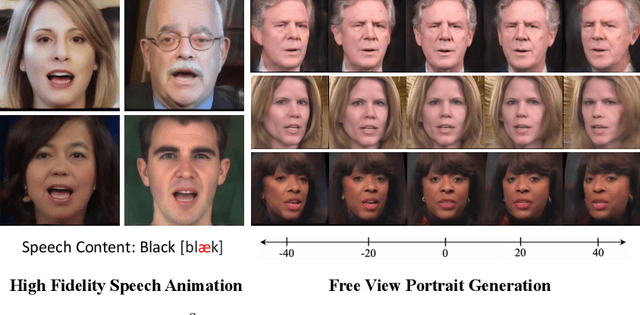
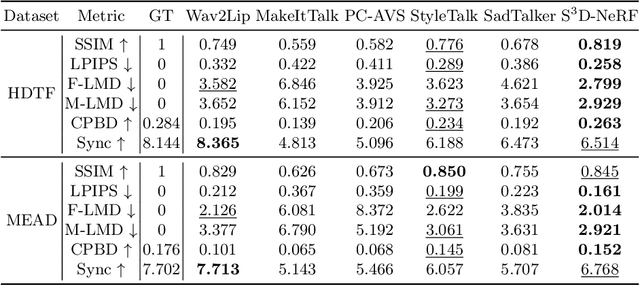
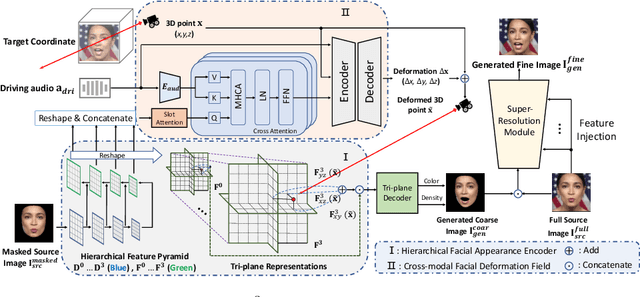
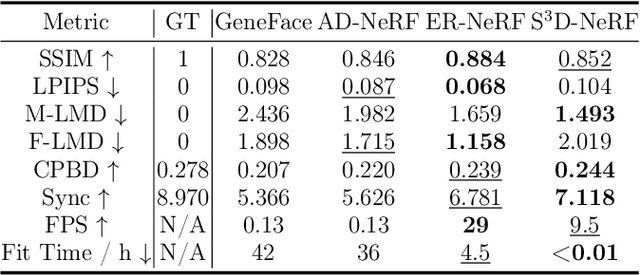
Abstract:Talking head synthesis is a practical technique with wide applications. Current Neural Radiance Field (NeRF) based approaches have shown their superiority on driving one-shot talking heads with videos or signals regressed from audio. However, most of them failed to take the audio as driven information directly, unable to enjoy the flexibility and availability of speech. Since mapping audio signals to face deformation is non-trivial, we design a Single-Shot Speech-Driven Neural Radiance Field (S^3D-NeRF) method in this paper to tackle the following three difficulties: learning a representative appearance feature for each identity, modeling motion of different face regions with audio, and keeping the temporal consistency of the lip area. To this end, we introduce a Hierarchical Facial Appearance Encoder to learn multi-scale representations for catching the appearance of different speakers, and elaborate a Cross-modal Facial Deformation Field to perform speech animation according to the relationship between the audio signal and different face regions. Moreover, to enhance the temporal consistency of the important lip area, we introduce a lip-sync discriminator to penalize the out-of-sync audio-visual sequences. Extensive experiments have shown that our S^3D-NeRF surpasses previous arts on both video fidelity and audio-lip synchronization.
Towards Black-Box Membership Inference Attack for Diffusion Models
May 25, 2024

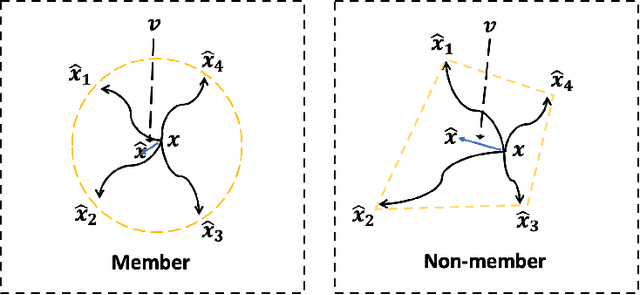
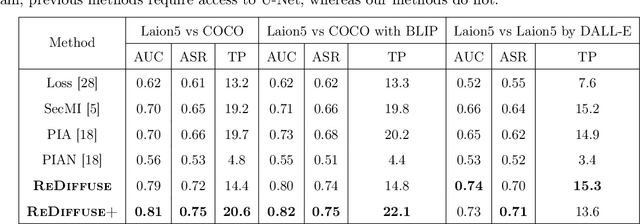
Abstract:Identifying whether an artwork was used to train a diffusion model is an important research topic, given the rising popularity of AI-generated art and the associated copyright concerns. The work approaches this problem from the membership inference attack (MIA) perspective. We first identify the limitations of applying existing MIA methods for copyright protection: the required access of internal U-nets and the choice of non-member datasets for evaluation. To address the above problems, we introduce a novel black-box membership inference attack method that operates without needing access to the model's internal U-net. We then construct a DALL-E generated dataset for a more comprehensive evaluation. We validate our method across various setups, and our experimental results outperform previous works.
 Add to Chrome
Add to Chrome Add to Firefox
Add to Firefox Add to Edge
Add to Edge